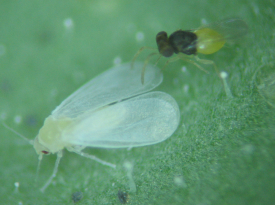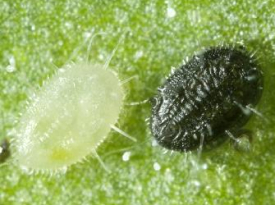- Track your orders
- Save your details for express checkout



Shopping
Tasman Lacewing for Aphid Control
Micromus tasmaniae - Predatory insect
Tasman Lacewings are a small predatory insect that predates on a large variety of prey including aphids, citrus whitefly and psyllids.
Tasman Lacewings are known to be useful in indoor and outdoor crops such as, capsicum, cucumber, citrus, and other ornamentals as part of an integrated pest management programme.
Tasman Lacewings are a predatory insect which as an adult grow to 7.5 - 10 mm in length. The Tasman lacewings are predatory in both the larvae and adult stages.
Known prey range in New Zealand as detailed by the Landcare Plant-SyNZ database include:
| Scientific Name | Common Name |
|---|---|
| Allaphis foxtonensis (Cottier, 1953) | Sedge aphid |
| Bactericera cockerelli (Sulc, 1909) | Tomato Potato Psyllid |
| Brachycaudus helichrysi (Kaltenbach, 1843) | Leafcurl plum aphid |
| Brevicoryne brassicae (Linnaeus, 1758) | Cabbage aphid |
| Cavariella aegopodii (Scopoli, 1763) | Carrot aphid |
| Elatobium abietinum (Walker, 1849) | Spruce aphid |
| Eriosoma lanigerum (Hausmann, 1802) | Woolly apple aphid |
| Eulachnus brevipilosus (Borner, 1940) | Pine aphid |
| Melanostoma fasciatum (Macquart, 1850) | Small hoverfly |
| Metopolophium dirhodum (Walker, 1849) | Rose grain aphid |
| Micromyzella filicis (Van der Groot, 1917) | Green fern aphid |
| Myzus ornatus (Laing, 1932) | Ornate aphid |
| Neophyllaphis totarae (Cottier, 1953) | Totara aphid |
| Orchamoplatus citri (Takahashi, 1940) | Australian citrus whitefly |
| Phenacoccus graminicola (Leonardi, 1908) | Grass mealybug |
| Pineus boerneri (Annand, 1928) | Pine woolly aphid |
| Pineus pini (Macquart, 1819) | Pine adelgid |
| Pseudococcidae sp. | |
| Rhopalosiphum padi (L., 1758) | Cereal aphid |
| Toxoptera aurantii (Boyer de Fonscolombe, 1841) | Black citrus aphid |
| Trioza vitreoradiata (Maskell, 1879) | Pittosporum psyllid |
| Neotoxoptera formosana | Onion Aphid |

The pest: whitefly (left) & the solution: Encarsia (right)

Normal whitefly pupa (white) and parasitized pupa (black). An adult Encarsia will emerge from the black scale(right)
The Pest: Aphids
Many different species of aphid are present in New Zealand. Some species are quite specific to particular crops, while other species infest a wide range of crops.
Aphids are soft-bodied insects that have globular bodies, long thin legs and antennae. Adult body length is normally 2-3 mm, and colour varies from pale yellow, green to dark brown or black. Some forms have wings and they can disperse rapidly.
Under optimum conditions, the life cycle of an aphid can be completed in 10-12 days. Many species reproduce asexually, and therefore populations can build up very rapidly.
Aphids feed with piercing-sucking mouthparts and can cause stunting and distortion, especially to younger leaves. Aphids are often plant virus vectors, and therefore rapid and effective control is essential to minimize crop losses.
Symptoms and signs of aphids include:
-
Stunting and distortion of the leaves and flowers
-
Yellowing and wilting of leaves
-
Honey dew and sooty mould present on the plants
-
Aphids visible on the stem, leaves and flower buds
Life Cycle
The adults are brown with two pairs of wings that cover their bodies. They have small heads with large black compound eyes and long antennae that are held out in front. The first larva stage is approximately 1.8 mm long and will grow to 7 - 9 mm within 7 days. Once a larva has matured it will form a pupa cocoon for around 10 days before emerging as an adult. The lifespan can range from 50 to 140 days depending on temperature and prey availability.
Environmental Conditions
Tasman lacewings are best suited to temperatures above 5°C, below this temperature threshold the young life stages will take additional time to develop.
Packaging
Tasman Lacewings are dispatched as eggs on a cloth packed in a box, and sent via courier.
Application Rates
-
1-5 Tasman Lacewings eggs per m2 as a moderate CURATIVE measure, over several weeks as aphids are found in the crop
-
Heavier infestations of aphids can benefit from the simultaneous release of Aphidius, or may require initial chemical intervention (contact Bioforce to discuss).
Release and Storage Instructions
Tasman Lacewings need the following handling and treatment:
On arrival, release Tasman Lacewings into the crop as soon as possible Do not expose Tasman Lacewings to direct sunlight DO NOT REFRIGERATE Release Tasman Lacewings near an aphid 'hot spot', and then evenly distribute the eggs throughout the area requiring treatment
Post Release
Tasman Lacewings will start predating aphids after hatching. The larval and adult life stages are both predatory.
Before introducing Tasman Lacewings into your crop please check residual chemical affects and ensure you know chemical compatibilities of products that may be applied.
A list of compatible pesticides and withholding periods can be found in the publication 'The Good Bug Book' Second Edition (2002), Editor Richard Llewellyn. Excerpts of the book can be obtained from the Tasman Lacewing page of the Australasian Biological Control Association website, click here then scroll to the bottom of the page and click on the PDF link.